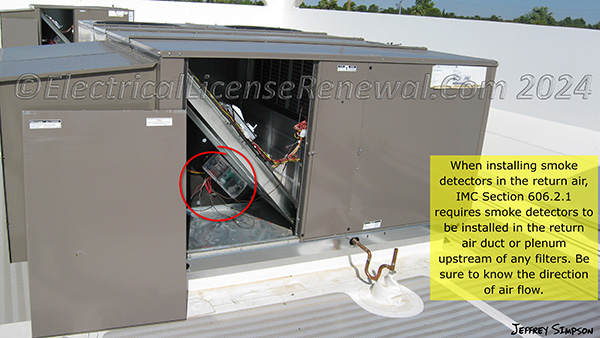Environmental Factors in Design and Installation.

Environmental factors play a significant role in the performance of alarm systems. Factors such as temperature, humidity, air flow, and dust can all affect how sensors and alarm’s function. For instance, high humidity levels in certain areas, such as bathrooms or laundry rooms, can cause smoke detectors to react to moisture in the air. Similarly, smoke detectors placed near HVAC vents may experience false alarms due to the movement of air carrying dust or steam.
Section 606.2.1 in the International Mechanical Code addresses smoke detectors installed in HVAC system ductwork. This section requires smoke detectors to be “installed in return air systems with a design capacity greater than 2,000 cfm (0.9 m3/s), in the return air duct or plenum upstream of any filters, exhaust air connections, outdoor air connections, or decontamination equipment and appliances (check all exceptions).
A common code violation occurs when a duct smoke detector is installed in the return air duct downstream of a return air filter. Installing duct smoke detectors upstream of filters as per IMC 606.2.1 ensures early and accurate smoke detection, maintains unobstructed airflow, preserves the reliability and sensitivity of the detectors, and ensures the installation aligns with the manufacturers installation instructions in accordance with NEC® 110.3(B). This approach enhances the overall effectiveness of the smoke detection system in reducing false alarms, protecting the building, and its occupants.
When designing and installing alarm systems, it is crucial to conduct a thorough assessment of the environment to identify any conditions that might lead to false alarms. This includes understanding the typical temperature ranges, humidity levels, and air flow patterns within the building. With this information, designers can select appropriate sensors that are less likely to be affected by these conditions. For example, in areas with high dust levels, heat detectors might be a better choice than smoke detectors.
Additionally, environmental factors can change over time due to changes in building usage or modifications to the building structure. Regular assessments and adjustments to the alarm system may be necessary to ensure continued reliable performance. Properly considering and mitigating environmental factors during the design and installation phases can significantly reduce the risk of false alarms and improve the overall reliability of the alarm system.